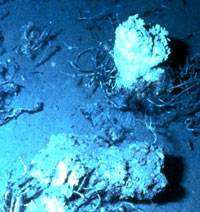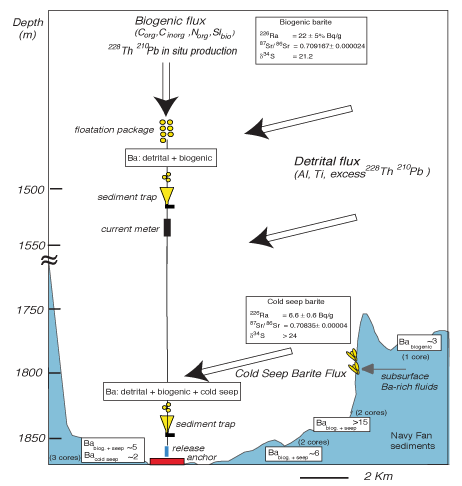


The Project
|
The Project: Research Question
The scientists want to know how much barite on the ocean floor comes from the cold seep, and how much is formed with organic particles that rain down from the ocean surface. So, they are collecting samples in two funnels called "sediment traps": one placed above the seep at 1500 meters water depth, and one placed below the seep at 1850 meters depth.
Mooring
Mooring animation The mooring with these two sediment traps was placed at the research site one year ago. When the mooring is brought to the ship on this cruise, the scientists will collect the samples from the two traps. The scientists will measure the amount of barite in the samples from each location. They will compare these measurements to discover the source of the barium. Barite is used in various industries related to gasoline production and oil-well drilling. This mineral also is used in making cement, rubber, urethane foam, automobile paint primer, vehicle brake and clutch pads, and “leaded” glass. Scientists now know that the deposits being formed on the ocean floor today are similar to barite formations currently being mined in Nevada, Arkansas and China. Since much of the barium that settles to the seafloor arrives with organic matter, understanding this barium is important for another reason. Geochemists use the barium buried in the ocean sediments to study the history of biological activity in the ocean. They want to understand how the animals and plants in the oceans responded to changes that have occurred in the Earth's climate in the past so that they can predict how climate change will affect the ocean ecosystem in the future. Other pages in this section:
|

 The scientists are collecting data about mineral deposits formed when fluids seep from an underwater cliff near the ocean floor. A decade ago, Marta Torres discovered deposits of barite in the ocean off the coast of Peru (pictured to the right). More recently, she led an expedition using a small deep-sea submarine, called the ALVIN, to investigate an offshore fault on the ocean floor. This fault is in the San Clemente Basin off Baja California. Here, scientists found what they call a "cold seep". This is an area where water seeps out from the sediment carrying chemicals including methane and barium. As barium (dissolved in the seep fluid) makes contact with sea water, if forms the mineral "barite" and leaves solid columns and pavements near the fault on the ocean floor.
The scientists are collecting data about mineral deposits formed when fluids seep from an underwater cliff near the ocean floor. A decade ago, Marta Torres discovered deposits of barite in the ocean off the coast of Peru (pictured to the right). More recently, she led an expedition using a small deep-sea submarine, called the ALVIN, to investigate an offshore fault on the ocean floor. This fault is in the San Clemente Basin off Baja California. Here, scientists found what they call a "cold seep". This is an area where water seeps out from the sediment carrying chemicals including methane and barium. As barium (dissolved in the seep fluid) makes contact with sea water, if forms the mineral "barite" and leaves solid columns and pavements near the fault on the ocean floor. 